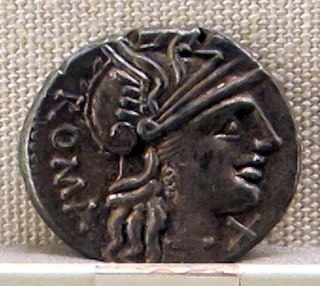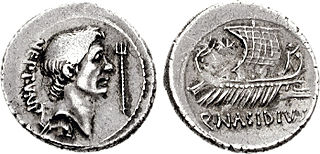Related Research Articles
The gens Scribonia was a plebeian family of ancient Rome. Members of this gens first appear in history at the time of the Second Punic War, but the first of the Scribonii to obtain the consulship was Gaius Scribonius Curio in 76 BC.
The gens Popillia, sometimes written Popilia, was a plebeian family in Rome. The first of the Popillii to obtain the consulship was Marcus Popillius Laenas in 359 BC, only eight years after the lex Licinia Sextia opened that magistracy to the plebeians.

The gens Minucia was an ancient Roman family, which flourished from the earliest days of the Republic until imperial times. The gens was apparently of patrician origin, but was better known by its plebeian branches. The first of the Minucii to hold the consulship was Marcus Minucius Augurinus, elected consul in 497 BC.
Aegus and Roscillus were two chiefs of the Allobroges, who had served Julius Caesar with great fidelity in the Gallic Wars, and were treated by him with great distinction. They accompanied him in his campaigns against Pompey, but having been reproved by Caesar on account of depriving the cavalry of its pay and appropriating the booty to themselves, they deserted to Pompey in Greece. Aegus was afterwards killed in an engagement between the cavalry of Caesar and Pompey.
The gens Atria was a Roman family, known primarily from two individuals who flourished during the middle years of the first century BC.
The gens Titia was a plebeian family at ancient Rome. The gens is rarely mentioned in the Republican period, and did not rise out of obscurity till a very late time. None of its members obtained the consulship under the Republic, and the first person of the name who held this office was Marcus Titius in BC 31.
The gens Sextia was a plebeian family at ancient Rome, from the time of the early Republic and continuing into imperial times. The most famous member of the gens was Lucius Sextius Lateranus, who as tribune of the plebs from 376 to 367 BC, prevented the election of the annual magistrates, until the passage of the lex Licinia Sextia, otherwise known as the "Licinian Rogations," in the latter year. This law, brought forward by Sextius and his colleague, Gaius Licinius Calvus, opened the consulship to the plebeians, and in the following year Sextius was elected the first plebeian consul. Despite the antiquity of the family, only one other member obtained the consulship during the time of the Republic. Their name occurs more often in the consular fasti under the Empire.

The gens Considia was a plebeian family at ancient Rome. The Considii came to prominence in the last century of the Republic, and under the early Empire, but none of them rose any higher than the praetorship.
The gens Laberia was a minor plebeian family at ancient Rome. Members of this gens are first mentioned in the second century BC, at which time they held senatorial rank. Most of the members mentioned later were equites, but toward end of the first century AD they attained the consulship, which several of them held throughout the second century.
The gens Mettia, also written Metia, was a plebeian family at ancient Rome. Few members of this gens occur in history, and none attained the higher offices of the Roman state under the Republic. Several Mettii rose to prominence in imperial times, with at least three obtaining the consulship in the late first and early second century.

The gens Nasidia was an obscure plebeian family at Rome. The gens is best known from Quintus Nasidius, one of the admirals of Gnaeus Pompeius Magnus during the Civil War. Although none of the Nasidii are known to have held any of the higher offices of the Roman state, a number are known from inscriptions. A coin of this gens depicts the head of Pompeius and a trident on the obverse, and on the reverse a ship, with the inscription Q. Nasidius.
The gens Pedia was a plebeian family at ancient Rome. Members of this gens are first mentioned in history during the final century of the Republic, and for the next two centuries they were distinguished in statesmanship, rhetoric, art, and law. The first of the Pedii to obtain the consulship was Quintus Pedius, the nephew of Caesar, in 43 BC.
The gens Petreia was a minor plebeian family at ancient Rome. Members of this gens are first mentioned toward the end of the second century BC, and several were distinguished as soldiers, but none of them ever attained the consulship.
The gens Satria was a minor plebeian family at ancient Rome. Members of this gens are mentioned in the first century BC, and under the early Empire, but none of them rose higher than the rank of praetor. Otherwise the Satrii are known largely from inscriptions.
The gens Silia was a plebeian family at ancient Rome. Members of this gens are mentioned as early as the fifth century BC, but first to hold the consulship was Publius Silius Nerva, in the time of Augustus. The Silii remained prominent until the time of the Severan dynasty, in the early third century.
The gens Trebonia, rarely Terebonia, was a plebeian family at ancient Rome. Members of this gens are mentioned in the first century of the Republic, and regularly throughout Roman history, but none of them attained the consulship until the time of Caesar.
The gens Tituria was an obscure plebeian family at ancient Rome. Few members of this gens appear in history, of whom the most famous is Quintus Titurius Sabinus, one of Caesar's legates during the Gallic Wars. Other Titurii are known from inscriptions.
The gens Trebia was a minor plebeian family at ancient Rome. Members of this gens are first mentioned during the second century BC, but none of them attained any of the higher offices of the Roman state under the Republic. Three of the Trebii reached the consulship in the time of Hadrian.
The gens Tuticana, sometimes written Tuticania, was an obscure plebeian family at ancient Rome. Only a few members of this gens are mentioned in history, but a number are known from inscriptions.
The gens Valgia was a minor plebeian family at ancient Rome. Members of this gens are first mentioned in the final century of the Republic. The most illustrious of the Valgii was Gaius Valgius Rufus, a poet contemporary with Horace, who became consul suffectus in 12 BC.